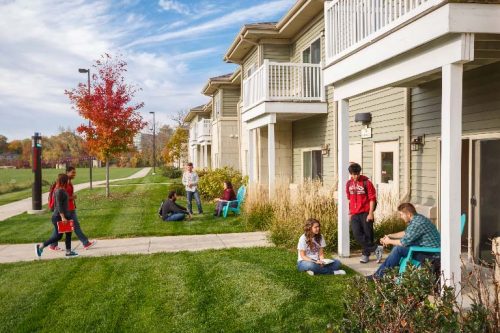
How bad is the housing crisis locally? On Thursday in the middle of August, students were coming out to discuss housing at the Planning Commission, even though the housing at Trackside is not designed for students and in fact will in most cases preclude student occupancy of the units. Nevertheless, the housing shortage and the 0.2 percent vacancy rate locally is profound and is starting to drive changes in the Davis market – some of which will be perceived to be negative ones.
While Davis’ local problem can be seen in locally-based issues – student enrollment increases at UC Davis combined with Measure R growth restrictions – the impact of UC Davis’ housing crisis is putting additional pressure on other communities and the region.
And it is happening at a time when the state is experiencing its own housing crisis. This month, for instance, state legislators are debating their own housing package which could have profound impacts locally and statewide.
CALmatters put out a piece last week that illustrated the breadth of the problem.
Cost of housing is a problem. While California has always been more expensive than the rest of the county, the gap has grown. According to the article, “The median California home is now priced 2.5 times higher than the median national  home. As of 2015, the typical California home costs $437,000, easily beating the likes of Massachusetts or New York.”
home. As of 2015, the typical California home costs $437,000, easily beating the likes of Massachusetts or New York.”
These costs have caused “California’s homeownership rate to dip significantly” despite low mortgage rates. “Just over half of California households own their homes — the third lowest rate in the country, and the lowest rate within the state since World War II.”
The housing crisis, they found, has a major impact on the statewide economy.
“The McKinsey Global Institute found that housing shortages cost the economy between $143 billion and $233 billion annually, not taking into account second-order costs to health, education and the environment. Much of that is due to households spending too much of their incomes on the rent or mortgage and not enough on consumer goods,” they write.
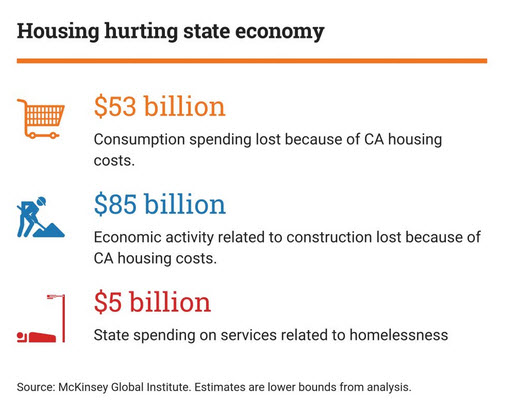
They add, “Even the attractive salaries and lavish perks of Silicon Valley struggle to overcome the local housing market, as young tech talent flees to the relatively inexpensive climes of Austin or Portland. Nearly 60 percent of Los Angeles companies in a recent University of Southern California survey said the region’s high cost of living was affecting employee retention.”
The article warns that the housing crisis will not get better any time soon – in particular for low-income residents.
“The state estimates that it needs to build 180,000 homes annually just to keep up with projected population growth and keep prices from escalating further out of control. Unfortunately, for the past 10 years, the state has averaged less than half of that. In no year during that span did California crack the 100,000 barrier,” they write.
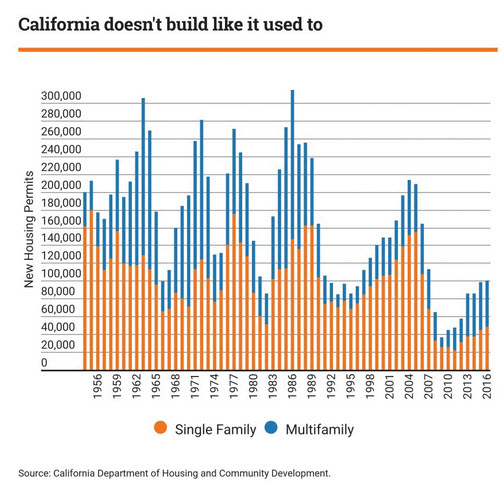
“There’s fierce debate over how long it takes low-income residents to benefit from the construction of new market-rate housing—a renter on the wait list for housing vouchers won’t take much comfort in the luxury condos being built in downtown Oakland or Los Angeles. While California faces an affordable housing gap at nearly all but the highest income levels, the low-income housing shortage is most severe.
“According to the nonpartisan Legislative Analyst’s Office, helping just the 1.7 million poorest Californians afford homes would cost $15 to $30 billion a year. The Los Angeles Times estimated that the three marquee bills considered by lawmakers this month would provide less than 25 percent of that total.”
How did things get this bad? Basically, housing could not keep up with the rise in population.
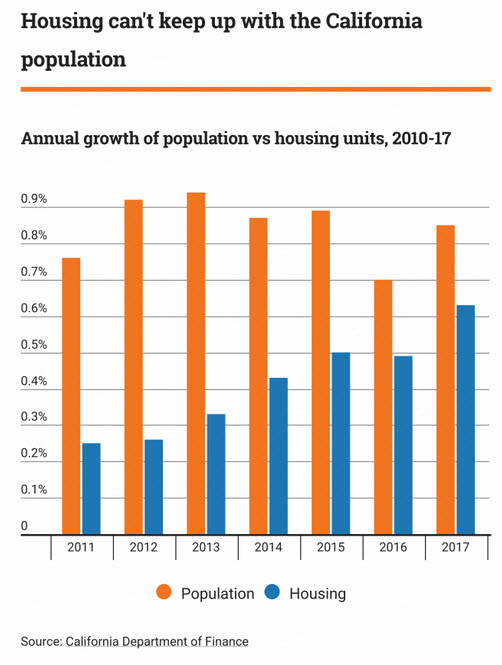
“From 2010 to 2017, the population of the state has grown 6 percent. That’s more than 2 million newly minted Californians, all with the nasty habit of wanting a place to live. Making matters worse, most are cramming themselves into our state’s large cities. In fact, 75 percent of the state’s new residents have sprouted up in urban centers with populations over 50,000 (don’t be too hard on them–that’s where most of the job growth has been).”
In addition, building new homes is expensive, particularly in California.
They find, “Part of the problem boils down to the (literal) nuts and bolts of housing development. Over the last five years, construction costs have been ticking up across the entire country.
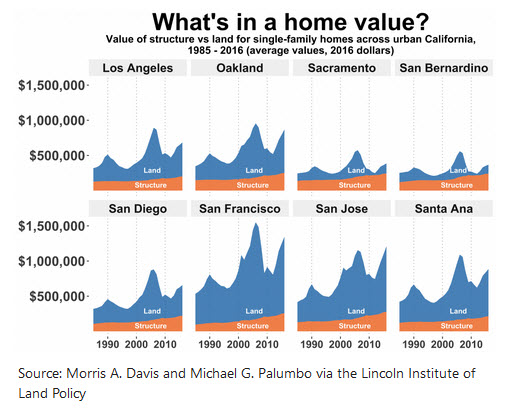
“A labor shortage in the home building industry bears much of the blame for this. When the housing market crashed in the late 2000s, construction workers left the industry in droves. Now that prices are back at nosebleed levels, those same workers haven’t come back. Across the country, employment in the construction industry is down more than 13 percent since the height of the recession. In California, it plummeted twice that far.
“Where have all the workers gone?” they ask. “Theories abound: tighter immigration laws, a dearth of skilled labor, the opioid epidemic, depressed wages, coddled millennials not knowing the value of a hard day’s work. Whatever the cause, it all makes it that much harder for developers to build homes on the cheap and easy.”
But they find that construction is only part of the problem and “sometimes a relatively small part at that.
“In most of the state’s major urban areas, the bulk of a single-family house’s price is locked into the land it sits on. That high price tag on the cost of actually buying a parcel and prepping it for construction not only makes new housing more expensive, it influences what kind of housing gets produced: developers prioritize high-end projects, since even the cheapest pre-fab unit will come stuck with a steep fixed cost,” they write.
“What makes land expensive? When it’s in shortest supply,” they continue. “Take San Francisco: Seven-by-seven miles of hillside penned in by water on three sides. Of the top 15 most physically constrained metro areas in the country, seven dot California’s oh-so-desirable coast. But many of those same coveted locales place additional limits on where—and when and how and how much—construction can take place. That all makes it that much harder for housing to keep up with population growth. And over the last decade, it has not.”
They ask: If not in your backyard, then whose?
“Who has cause to celebrate when a new housing project goes up in your neighborhood?” they ask. “Young homebuyers, nearby businesses, new arrivals to the area, and, of course, developers. But people who have been living in the neighborhood for years may worry that the new development will depress the value of the homes they own, or trigger increases in the rent they pay. Those who prefer not to live next door to a construction site, or watch their zucchini garden wither in the shadow of a garish new condo building, have plenty of reasons to object.”
They continue, “And object they do. With the exception of one irregularly enforced state law, land use planning in California is a local process—and one that affords opponents of change ample opportunity to stall, stymie, or scale down. The tool kit of local obstruction includes zoning restrictions, lengthy project design reviews, the California Environmental Quality Act, parking and other amenity requirements, and multi-hurdled approval processes. In California, you’re most likely to find these extra restrictions where developable space is already scarcest—in coastal urban enclaves.
“Local pushback might be rooted in concerns about the environment, about congestion, about the creep of gentrification, or in a desire to preserve the ‘character’ of the neighborhood (however that might be defined). But whatever the flavor of NIMBYism and whatever its ultimate goals, higher hurdles to development in the state’s most desirable locations mean many cities have failed to add new units fast enough to keep up with population or job growth.”
This is the problem we face in Davis. Local land use laws such as Measure R have restricted the ability of the city to grow outward. But at the same time, there is a battle for infill between neighbors who either want less density and height or nothing altogether, and developers looking to maximize profit and council leaders looking to maximize the provision of housing – this has led to heated and extended battles over relatively small projects while the city continues to lag in its ability to supply needed housing for students and also for working people and families.
The bad news is that, while many have blamed the enrollment growth for growth pressures in Davis, statewide trends suggest there would be pressures regardless.
—David M. Greenwald reporting







We cannot build our way out because that just stresses the rest of the infrastructure. Time to address the demand side of the equation.
That (demand side) would be procreation or immigration… or decreased mortality… which do you propose we address first?
For Davis, we could just let infrastructure and social service networks go to hell, and that could decrease local housing pressures…
You neglected migration. However the country has plenty of housing, just not where people want to live. So therefore you either build huge numbers of new residences on the coast or you encourage people to want to live elsewhere.
Jim, how do you “encourage” people to want to live in places other than on the coast?
I personally believe that the whole concept of “encouraging” people to want to live in particular places is highly suspect.
To the best of my knowledge Dave Taormino can’t even “encourage” Davis seniors to actually act on living in his proposed senior development. Davis seniors talk about wanting to downsize, but when it comes time to actually write the check for the new home deposit, they decide to stay in place. As a result, the majority of any residences that might be built on Taormino’s site are likely to be bought by people who currently don’t live in Davis.
“Jim, how do you “encourage” people to want to live in places other than on the coast?”
This is a good question and I’m not certain I have the answer. Right now we discourage people from wanting to live in a certain area through high prices and low quality of life.
Then we see articles like this about how housing is “affordable” and I think “that is the point of our current policy”. Here are some random thoughts:
I used to do a lot of work with AMGEN in Thousand Oaks. The TO area was expensive so they had acquired a company in Colorado which had a building and they were moving some of the lower paid functions to the Colorado facility where the cost of living was less. There is plenty of space in Chico or other towns, how do you encourage large employers like UC to place accounting and other clerical operations there? Do all the employees really need to be on campus? Bosses like to walk around and see all the minions in their empire so it’s a bit of a cultural chance.
The Mayor of Detroit is very much interested in increasing the number of immigrants to generate economic activity. There are several cities that could use additional people and have existing housing stock. We have too many and they have too few.
Just offhand.
Part of building is using the devevelopers to increase infrastructure. Part of the problem in the last two decades is not only decreasing resources, but fewer developments which means fewer developer financed capital improvements.
If you don’t build more housing, how do you house everyone?
There is plenty of housing, just not where people want to live. Maybe people need to go where the housing is.
Developers never take care of the big infrastructure like the 80 freeway. Are you aware that traffic on the 80 can be very bad?
Or perhaps they need to put housing where the people are.
Well if you don’t drive, or can adjust the time of day you drive, I-80 is no problem… at all… it is largely a behavioral issue… barring somebody doing a stupid and causing a crash, I seldom have a problem with I-80…
It would be less of a problem if people and their jobs were in the same community…
I didn’t realize that Jim was such a no growther.
I am not a no growther but I also don’t feel that we need to build houses for everyone who wants one wherever they want one.
We have plenty of under utilized resources in this country.
Methinks it is who “grows” it… guess he was/is exempt… perhaps Davis was “right-sized” the day after he arrived… a subject he ‘religiously’ avoids…
Somewhat separate comment… I gag when I hear someone at public comment at CC meetings start out with “I’m a long-term Davis resident of 7 years, and…”
Years ago, addressing a public meeting, where I had been asked for my creds, I started out by saying I was a ‘newbie’, having only lived in Davis for ~ 30 years… Donna Lott, Maynard Skinner, Al Smith and a few others laughed so hard that I was afraid they’d have an ‘accident’… they recognized I knew I was a ‘newbie’ compared to them… but they also recognized, when my presentation was complete, I knew my ‘stuff’… length of time isn’t wisdom… lack of time is not a “cred”…
Howard:
No one is suggesting displacing existing residents. Not sure why you keep bringing that up.
A question for you: Notwithstanding the needs created by UCD, should Davis (or any other town) continue to grow/develop indefinitely, to meet market demand? (For example, in excess of SACOG fair share growth “guidelines”?)
Since this article deals with statewide growth, is 40 million people living in California “enough”? Maybe 50, 60, 70 million . . .?
More than doubling already, in my own lifetime.
You logic is flawed… growth pressures (what Jim brought up,not me) can only be ‘mitigated’ in three ways… lack of procreation, lack of migration/immigration, out-migration including death/mortality. That’s pretty much it.
You speak an untruth (no surprise there) when you say, “No one is suggesting displacing existing residents. Not sure why you keep bringing that up.” No,YOU did, not me… “.
So, getting out of defensive posture, please articulate how, given your shifting the question from local to statewide… “Since this article deals with statewide growth, is 40 million people living in California “enough”? Maybe 50, 60, 70 million . . .?”
How would you deal with the issue (which is real)? Local and/or state-wide? Let’s hear a suggestion rather than a ‘snipe’… afraid of becoming a ‘minority? having your racial and/or economic ‘privilege’ taken away? “Man-up” or…
How about world-wide, as those population increases and economic factors relate to drivers of the most of the national, state-wide, local (including UCD enrollment) increases? Man-up…
I await your suggestions other than building housing for those here… or likely to come…
Footnote to Ron…
When I was born, worldwide population was 2.7 B… now at 7.5 B…
In the 7th/8th largest ‘economy’ in the world (CA) 75 million would be 1%… think about that…
Twist that however you want.
What “issue” are you referring to? Market demand? Or – the fact that some want to continue on the same course (leading to a population of 50 million, 60 million, 70 million . . .)
One of the reasons that much of the Bay Area is (still) desirable has to do with a refusal to continuously accommodate market/developer demand, thereby ensuring livability, open space, adequate resources, protection of remaining agricultural areas, manageable traffic (in some areas, at least), etc.
Nah, Ron, you can do the “twist” much better than I… I concede…
[Previous response went into the ‘bit bucket’]
‘Migration’ is implicit in ‘immigration’. Duh. I chose my word accurately.
Dad ‘migrated’ from PA to CA right after the Korean War… he was considered an ‘immigrant’ to CA, an “out-migrant” in PA… all a matter orf perspective.
Yes, many other places where people could/should go… Barrows, AK… Elko, NV… Bodie, CA (get your hantavirus shot, first), Luckenbach, TX… great climate, job opportunities, low housing costs, etc. You ought to consider the opportunities for you to relocate…
I immigrated from the Bay Area (coastal region) 45 years ago (yeah, a “newbie”)… so, how long has it been since you migrated/immigrated to the area? Last in, first out (?)…
Immigration is a subset of migration and in common usage means people coming from another country. People migrate from Davis after college, often to LA, SF, or Seattle.
https://www.vocabulary.com/articles/chooseyourwords/emigrate-immigrate-migrate/
Many migrate/immigrate to Davis for college, and stay…
When again did you ‘migrate’ here? If you hadn’t then, should you be allowed to, and find housing today?
Oh… I’m not ‘common’ … I actually think…
And using your interpretation of ‘migration’ do you have any problems with ‘migration’ or ‘immigration’ [a subset, as you opine?]
Should Davis ‘build a wall’ by availability or affordability? Would be interested in your views…
“Oh… I’m not ‘common’ ” But you can aspire…
Clever… not.
Usually used by those on the left side of the ‘bell curve’ where aspiration to the median is a noble goal…
I’m skeptical of self reported data.
As am I… big time…
And now I understand why you don’t answer the question of how long you you have lived in the Davis environs…
Howard, I am a real person, you can look it-up. You are anonymous,
“There’s fierce debate over how long it takes low-income residents to benefit from the construction of new market-rate housing—a renter on the wait list for housing vouchers won’t take much comfort in the luxury condos being built in downtown Oakland or Los Angeles”
Nor those proposed for Trackside since you brought it up specifically. IMO Trackside is not designed to meet a real housing “need”. It is meant to meet the desires of local developers and investors and very high end renters. It holds no promise of meeting a local need as there is no guarantee that those who would occupy the 27 proposed units would be those here in town who need housing. Some would doubtless be individuals who currently have homes in Davis and would like to downsize. I have spoken to a few directly. However, we have no idea that we will not be importing from adjacent communities those who merely want to be closer to the train station as a point of departure to their work in Sacramento or the Bay area. This is a “nice to have project” for those it benefits, not a meets community “needs” project.
You’re absolutely right Tia…
We should, as a community, buy the property (@ no profit for the developer/investors) and use community resources to build housing for the homeless, and others who need housing (if they currently are living and/or working/studying in Davis)… make it 6-7 stories, to do the best we can… [my words/concepts, NOT Tia’s!] I like!
However my concept would fit with sentiments Tia expressed… no profit for developers/investors, meeting local need (no “imports”), and affordable … truly ‘progressive’ and noble… let’s do it!
“t holds no promise of meeting a local need as there is no guarantee that those who would occupy the 27 proposed units would be those here in town who need housing”
Which is exactly the same as “Affordable Housing” which draws from a regional list.
I agree with Tia’s comment. Trackside’s 27 units are not even going to offer any affordable units. In fact, the City will not get any in lieu fees either, in exchange for the affordable units that they should be including in the project. Plus, on top of all of that, these are going to be very expensive apartments and the city will get no SACOG RHNA credit for them either. Add all of these factors up together with how the Trackside project is breaking the rules on so many City planning policies and principles, including violating the zoning, it winds up being just another example of bad planning by the City. Trackside can be a good project if it is downsized more to be compatible with the neighborhood. The City needs to back its own planning rules and not forge forward with “shoe-horn” infill planning.
The fundamental problem of the need for housing goes back to the need for UCD to provide the needed on-campus housing. UCD has over 5,300 acres and the ability to do it. UCD needs to move forward with providing the on-campus housing for its growing student population like the other UC’s are to help this situation.
I agree with you that Trackside isn’t providing much in the way of housing options and the target doesn’t seem to be a priority need.
I’m still troubled by your repeated 5300 acre claim when it’s clear that those aren’t all developable acres by the university.
UC Davis is driving a lot of housing needs, but it’s not the ony driver.
David,
UCD is a major driver of the need for housing.
Agreed
Yes Eileen… if UCD did it’s share, there would be no issues… and until they do, the community does nothing… got it. Very clear. We are different from the rest of the State… superior…
David,
We provided UCD with over 100 acres of options for student housing on or near the UCD core campus, and there are plenty of options beyond that. The issue is that UCD is the largest UC campus and has plenty of options.
Which is good, but it’s not 5300 acres. I don’t disagree with your thrust here, but prefer to talk in more realistic terms.
The portion of UCD where housing could reasonably be developed, running from Russell Blvd. to I-80 and stretching a little west of West Village, is about 1600 acres.
Which seems reasonable, so why not simply use real numbers that accurately describe the situation? I wasn’t doubting that there was ample space for the housting needed.
David,
The fact is that UCD is the largest UC with over 5,300 acres and the recommendations we pointed out are only a small part of the many options they have. Why limit or diminish the possibilities of where more on-campus housing could be located? That would be counter-productive.
We need UCD to be open-minded enough to be creative about how they can significantly increase the amount of housing on-campus, instead of minimizing it. Look at Webster Hall where UCD is spending a fortune in demolishing 3-story Webster Hall on Oxford Circle only to replace it with 4-stories, which is squandering that opportunity to provide far more student beds there.
There you go again with the 5300 acres…
The draft EIR will be posted in the next few weeks and will probably go to the regents after the first of the year. We’ll know shortly what UCD is willing to do.
David,
There you go again with trying to diminish the enormous amount of land and resources that UCD has.
Also, why isn’t the Vanguard covering how UCD is squandering of UCD’s Webster Hall demolition on Oxford Circle, to great expense and adding only one story from 3- stories to only 4-stories. Meanwhile, a private developer is building a student housing project which will be 5-stories right next door to Webster Hall, which is an area which could handle that.
Meanwhile, not one word has been covered on this UCD Webster Hall issue on the Vanguard. Why is that?
Start your own newspaper or blog… easiest answer…
If you want something covered you have two options – (1) write it yourself, (2) send me information and I’ll see if I want to write on it. I don’t believe I’ve ever turned you down in either regard.
Howard,
I appreciate that you recognize that UCD is a major player in this issue. The problem is the City has limited amount of land left and we need to provide housing for non-students as well. So the obvious obstacle is UCD which needs to step up for the sake of their students, Davis, and surrounding communities all being impacted by UCD’s lack of adequate on-campus housing. UCD has the land and the ability to provide the housing needed for its own growth. If other UC’s can do it, UCD can do it.
Davis “has the land” too… if they choose either to annex the land, or accept approvals by the County to develop adjacent… land is not the issue…politics is…
Howard,
It makes no sense for the City to annex in land for UCD housing needs when UCD has plenty of land for its own housing needs since it has over 5,300 acres. Also providing the housing on campus controls the costs long-term and reduces carbon footprint since it eliminates the commuting impacts by thousands of students.
Glad to see the Vanguard giving the larger regional context some attention. But there’s another implication here. It’s going to be very hard for Davis to build enough to change rental rates because of the statewide need for housing. That is, we can build and build, but even if prices were to go down, that just makes Davis all the more attractive for someone commuting to the Bay Area, and prices will go up again. So, for those of us who are concerned about protecting students, on-campus housing makes more sense, because the rents can be controlled.